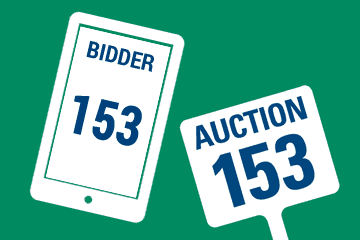
Planning an event is no easy task, and when faced with choices of transitioning between the ‘old-school’ bid paddles or utilizing mobile technology to capture donor information for your Fund-a-Need campaign, it’s important to weigh the pros and cons between the different ways you can solicit donations during an event.
Let’s delve into the best practices for the most common types of Fund-a-Need approaches you’re going to consider when planning your organization’s campaign to solicit donations during the event night program.
Bid Paddles—Pre-printed cards with large-font numbers printed so spotters can easily see who is making the intended donation.
- Pros: If you’re conducting a live auction, you’ll most likely already have these printed and can re-purpose them as you transition into your call for donations. They also are more exciting as you see cards fly in the air, and can easily convince those around the room to raise their own cards.
- Cons: Pre-assigning bidder numbers and then stationing volunteers to help distribute them can be difficult, especially if you’re expecting to print the names and tables on each bidder card.
Text to Give—Using a third party vendor and displaying a short number guests can send a text to on their mobile phone.
- Pros: Doesn’t require phone numbers to pre-register.
- Cons: Typically, these programs require a follow-through on behalf of the donor or the organization to finalize credit card information to secure the donation.
Mobile Bidding Platforms—Third party vendors that utilize technology to communicate with the guests for silent and live auction events. Many of these vendors, like Greater Giving’s Online Bidding, also have dedicated functionality to accept donations directly through the bidding area.
- Pros: Instantly add donations or appeal levels to a bidder’s account. Tools like Greater Giving have the ability to store credit card information so there is no need for the organization to follow through to secure payment information.
- Cons: Buzz and excitement is more challenging to navigate if you don’t have an experienced auctioneer working the crowd.
There are some general rules you can follow to help ensure a successful Fund-a-Need no matter what type of method your organization chooses to solicit donations…
Be sure to go one level at a time in correspondence with your total goal. If you have a goal of $50,000, start your first level at $10K. If it’s a $10,000 goal, start your first level at $1K. You can make a bigger impact by securing people in your audience to make leadership gifts (pay for their sponsorship or their annual large donation by placing it here) and watch the frenzy and excitement skyrocket as others then push to make their own donation. Then descend into smaller denominations spending no more than 10 minutes during this part of the program.
One fun game you can try at the end of your appeal is to give a prize to the final donor who makes a donation during this call to action. This is best implemented at the $100 level and helps push out the final stretch of donors to see who will receive the surprise for being the final donor here. A bottle of champagne, restaurant gift card, or their car waiting for them at the valet stand can all be fun prizes used to further engage your audience.
Most importantly, remember to have fun and engage your audience—they are there for you!

I love going over the pros and cons on whether or not to use the traditional Paddles or the new app based technology. If you are worried about how it will be accepted – try at this year’s event to see if that would be something the current bidders would like to see at your next event. How? Ask of course! 🙂